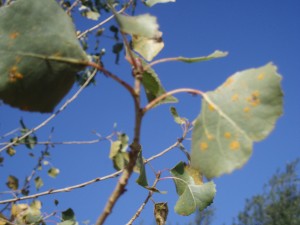By Sheri McGregor
 On a recent warm fall day, bees buzzing around a native cottonwood tree captured my curiosity. Squinting up through the dwindling leaves of the ten- or twelve-foot tree, I could see that the bees didn’t look as if they were entering or exiting any hive. Quietly, I stepped closer to investigate. Small yellow-orange pockets clung to the leaves’ undersides.
On a recent warm fall day, bees buzzing around a native cottonwood tree captured my curiosity. Squinting up through the dwindling leaves of the ten- or twelve-foot tree, I could see that the bees didn’t look as if they were entering or exiting any hive. Quietly, I stepped closer to investigate. Small yellow-orange pockets clung to the leaves’ undersides.
The bees appeared to gather the substance. Do cottonwoods release pollen through their leaves? I wondered. I’d never heard of such a thing, but the bees’ action puzzled me. They hovered about, collecting the substance into thick saddlebag shapes on their hind legs.
Video: Bees gathering leaf rust (short)
Excited and intrigued, I later discovered through research that the substance is a fungus, melampsora, which infects cottonwoods and some other trees. As it turns out, honeybees collect the fungus, commonly called leaf rust, and take it back to their nests for ingestion same as they do pollen. Scientists have a number of theories for the behavior, ranging from wider nutritional needs to not enough flowers blooming close to the hive. Who knew bees enjoyed a varied diet?
Bees have always fascinated me. Five or six years ago, feral bees began a hive in the hollow wall at one end of my property, and I welcomed them. A friend told me that, at a time when bee populations the world over suffer from the use of pesticides and habitat infringement, their arrival at my place must be a good omen. I liked that analysis. Nature provided my own little symbol of prosperity!
The bees’ presence, though, has required some adjustment. My family has learned to work around them. We try to do any yard work near the hive in the early morning or in the last light of day to avoid their more active hours. When guests come to sit by our small pond with its natural-looking rock fountain, we warn them not to get too close. On sunny days, bees are always present at what has become their watering hole, and for the most part, we comfortably cohabitate.
When you’re hiking our natural spaces in San Diego, watch for bees. The insects form new hives in the spring. On several occasions, I’ve been fortunate enough to see this activity. Once, trekking over the rise of a hill on a clear spring day, I first heard a low roar then looked up to spot a black cloud of bees. I ducked, the swarm whizzed over my head, and I pivoted to watch them fade into the distance. At other times and other places, I’ve been fortunate to see bee masses cluster around the landed queen. I’ve never been stung by a bee while hiking . . . only in my own yard!
In the future, I hope to learn more about beekeeping and perhaps harvest honey from some cultivated hives. For now, I respect and marvel at these insects that are so vital to pollinate our food and flowers. Their industrious presence enriches my world.
FIND OUT MORE:
* Learn about honeybees and pollinators of all kinds and get involved in their preservation: Pollinator Partnership
* Learn about leaf rust and some other diseases: Colorado State University Extension article
* Read about honeybees’ and fungi: Daniel McAlpine Memorial Lecture